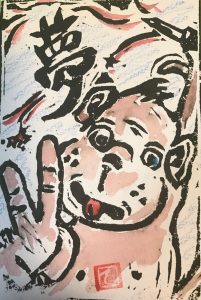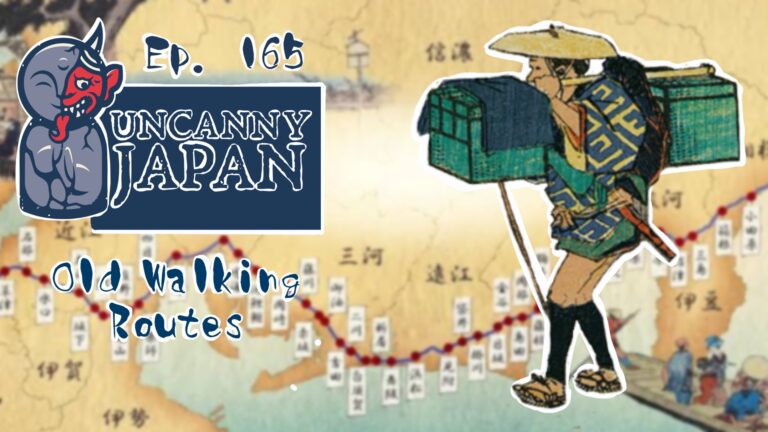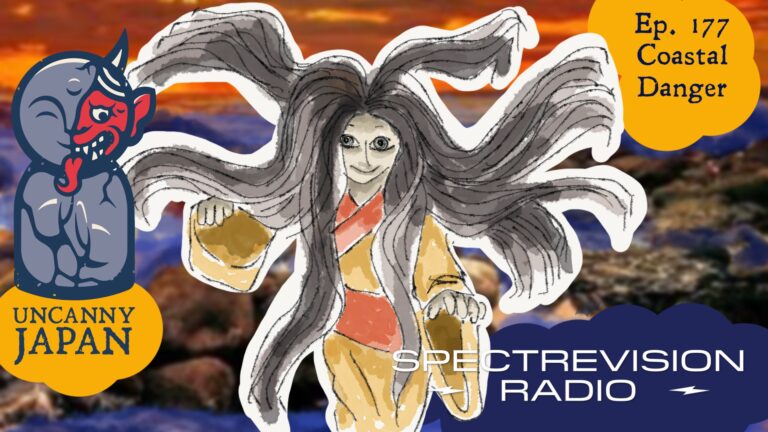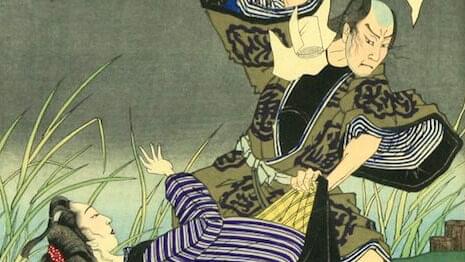
Introduction
Hello, Uncanny Japan is author Thersa Matsuura, that’s me, exploring all that is weird from old Japan. Strange superstitions and old wives’ tales, cultural oddities, and interesting language quirks. These are little treasures that I dig up when I do research for my writing. And I want to share them with you here on Uncanny Japan. I hope you like the show.
Hi, this is Thersa, and this is Uncanny Japan. I hope this podcast finds you well.
Before I start, I’d like to mention really quick that my new book, *The Carp-Faced Boy and Other Tales*, has just come out on Independent Legions Publishing. It’s a collection of dark horror stories. There’s 10 of them set in Japan. Yeah, they’re kind of dark. You can find it on Amazon, among other places, I suppose. The Kindle version last I looked was quite cheap. I think it was like $4 and a penny. So if you’re interested in that, take a look.
Also, before I start, my Patreon page I have up. It’s @teresamatsura. That’s spelled funky, T-H-E-R-S-A-M-A-T-S-U-U-R-A, Thersa Matsuura. There I have, I think, some interesting rewards. For example, for $5 and up, I will send you a monthly bedtime story. That is me retelling and often reimagining an old Japanese folk tale. I try to go for the more obscure ones, so there’s no Momotaro or stuff like that. This is stuff that’s kind of out there. If you like that, please give it a look. If not, that’s fine, too.
Setting the Scene
So today I am at a river. But as you can tell, there are also cars going by, because it’s a river with a road that goes kind of around it. It was raining all day today, and it got late in the day. This is as far out as I could get. But there are nice birds whenever they fly by, so you might be able to hear them.
Monkey Folklore and Superstitions
Today I’m going to talk about monkeys.
Now, I have a very love-hate relationship with monkeys. I love them because I do a lot of research on them, and I write about them quite a bit. I have a story in both of my books with a monkey in it. I don’t like them so much because I was actually molested by a monkey once, but that’s a long story. We’ll talk about that later.
So there’s three things I want to talk about. Monkey lore and superstition is quite vast and complicated or just confusing, because history is so long, and monkeys can be good, and monkeys can be bad, and depending on what you’re looking at, there’s a weird mash-up of Buddhism and Shintoism going on. And yeah, it can get a little bit overwhelming.
So I’m just going to stick to three things that keep coming up in my research. And one I talked about last time. Just want to kind of reiterate, say it one more time, but I also want to add something.
1. Monkey Wordplay: Saru (to Drive Away)
And that is the monkey word play. So monkey, “saru,” is monkey, right? Same pronunciation, different character. “Saru” means to expel, to push out, drive away.
So monkeys were thought to drive away or push away or get out, scoot away bad luck or diseases, demons even. Particularly smallpox, as far as diseases goes.
My first book, *Auroba Feathers and Other Stories*, there’s a story called “Yaiichiro’s Battle.” And I think you can find that online, even. But in it is a monkey that is supposedly supposed to drive out smallpox.
Saru-mawashi: Monkey Trainers
So what they did was they had these monkey trainers called “saru-mawashi,” and these men would come into towns. They would have the monkey dance in front of the afflicted person. And there’s two trains of thought here.
One was that the actual dance would drive away the disease and heal the person. The other one was that it just predicted whether or not the person would live or not. I can imagine that the man decided if someone didn’t look like they were going to get better, he could go to the ladder and say, yeah, my monkey’s telling me, aunt Momoko’s not going to make it. So I don’t know. I don’t know exactly who believed what or where. But both of those ideas were kind of side by side.
So that’s monkey saru, to drive out.
The Double-Edged Nature of Saru
What I think is interesting is—so saru means to drive out. But it doesn’t say what’s being driven out. And I always wondered about that. And then I actually did dig a little further and found that if these saru-mawashi, these men with their trained monkeys, would go into a village or a town, and the town was afflicted with disease, it was poor, they were hungry, then they could do their little dances door to door or in the town square or wherever. And people would give them money and applaud and yay, because it was believed the monkey would drive out the bad luck or the demons or whatever was bringing the bad mojo to their town.
Now, if they happened to land in a town and they had to stop because they needed to eat and sleep, but the town wasn’t doing so bad, like nobody was sick and they were eating OK and no one was super poor, they would get chased. There were a lot of rocks and sticks. They would get chased from the town. They would get driven out, right?
Because they thought that the townspeople would think that the saru, the monkey, would drive out their good luck or their fortune. So I kind of think it’s funny that that kind of turned on its head.
So they didn’t know what town—but basically, I’m thinking very, very old Japan. It’s a good bet that you’re going to go in there. Someone was going to be sick and you can make some money. So that’s number one. I wanted to talk about that and just say a little bit more about monkey, saru, and to play on words.

2. Monkeys and Horses
Next, number two, monkeys and horses.
Look at any old, a lot of old, Japanese art, scrolls, engravings, sculptures, paintings. You’ll see monkeys and horses, usually a monkey riding a horse.
Monkeys were thought to protect the health and the safety of horses.
Theory One: Journey to the West (Saiyūki)
There are two theories on this. One comes from China, actually. So the idea is that there’s an old Chinese folk tale. You might have heard of it. It’s called “Saiyūki, Journey to the West.” I think there’s lots of English versions out there. I think there’s probably anime and movies. I started the manga, but I haven’t finished it.
But in there, there’s a monkey. Monkey is greedy and obnoxious, as monkeys tend to be, and he’s going on and on about how he wants an important job. The Jade Emperor swoops in and says, hey, I got a job for you. It’s very important. Why don’t you take care of horses? You’re in charge of all the horses.
So the monkey’s like, yay, get to take care of the horses. And that thought, that superstition folk tale, came to Japan, and when it got to Japan, it was just kind of connected, monkeys care for horses. So you see them a lot together in old art.
Theory Two: Monkey Trainers as Horse Doctors
The other, the second idea, the second theory, is that the Saru-mawashi—I talked about him just a second ago, so he’s the monkey Saru-mawashi means to spin or to train, the trainer—would come around, again, town to town. Now, these guys, before they were called Saru-mawashi, they were called Saru-hiki. Hiki means to pull. So imagine this dude pulling a monkey from town to town.
He wasn’t just a monkey trainer, or had the monkey perform. He was also a horse doctor. So what he would do is he would go in, he’d find the stables, he’d go, he’d look at the horses, take care of them, whatever they needed. Meanwhile, the monkey’s dancing. So that kind of got meshed together, and monkeys were thought to take care of or protect horses.
Monkeys in Stables and Battle
You will find, if you go to any old stables in Japan, usually in the eves or somewhere in the stable, you’ll find monkeys engraved or something. It was believed if you had some picture or an actual monkey living in the stable, your horses would be strong. And of course, if they went into battle, they wouldn’t get hurt was the idea.
Speaking of going into battle, monkey hide or monkey skin was used to cover arrows. Samurai warriors would wear the arrows on their back or strapped to the horses. If they were covered in monkey hide, again, it would protect the horse from injury.
Tōshōgū Shrine and the Three Wise Monkeys
There’s a famous shrine in Nikko, Tōshōgū Shrine, and it’s for Tokugawa Ieyasu. And there’s a huge stable there. And on the eves above all around that, you can see the three wise monkeys, which we talked about again last month. The see no evil, hear no evil, speak no evil. Nizaru, Iwazaru, Kikuzaru.
And those, again, I think that’s one of the origins. They believe one of the origins of the three wise monkeys. So those monkeys are protecting horses. So that’s two.
3. Monkey Good Luck Charms
Now number three is monkey good luck charms. You can find these all over Japan, although they’re usually—they’re mostly sold in like around Kyoto and Nara. Two main ones.
Sarubobo: The Faceless Baby Monkey
The first one is called Sarubobo, Saru Monkey. Bobo is this little amulet originated in Takayama, Gifu Prefecture. And Bobo is a dialect which means baby. So it’s baby monkey. Sounds cute, right?
No, not cute at all. Actually quite creepy.
They’re all red. They’ve got a kind of bib and a kerchief on. Pointy legs and hands. Don’t look like a monkey at all. There’s no ears. There’s no tail. And creepiest of all, there’s no face.
These little dudes are—yeah, they’re just like little things with no faces.
Why No Face?
There are also some thoughts on that. One is that they were made from scraps. Difficult to make a face when you’ve got just tiny scraps of cloth. This is how poor the moms were when they were making these things.
Second idea was that the owner would imagine the face he or she wanted on the little doll, the little good luck charm. So I don’t know. That’s kind of creepy too, right?
And then the third idea was that they were made during World War II. That’s when they were starting to get made. And things were so bad at the time that there wasn’t a lot of good news, happy news. The moms were making just little toys for their children to play with. And they couldn’t bring themselves to lie to their children and make a happy face. And yet they didn’t want to make a sad face. So what are you going to do? Make no face at all, I guess.
So those are sarubobo. I got one of those. I’ll put a picture up online.
Migawari-zaru: The Substitute Monkey
Similar, but a little bit different is number two, migawari-zaru, also called kukuri-zaru, which means tied-up monkey.
So migawaru, mi means body. Kawaru means to change. So they’re called substitute monkeys or scapegoat monkeys. Weird.
Basically, they take on any of your bad juju, and they make it good, I suppose.
Similar to the sarubobo, they’re all red. They’ve got the pointy little legs, the pointy little hands. No face, no ears, no tail. But what makes these guys a little bit weirder than the sarubobo is that they are hog-tied. Their little legs and their little hands are tied up behind them. And they’re strung up on a long line. There’s usually several stacked on top of each other, quite a few. And they’re hung up in houses, like again, in the eves by the front doors and thought to bring good luck.
You can see these in Kyoto and Nara, all over the place, actually, and buy them there as well.
The Wish Trade
What I’m going to end on is I kind of like this idea. The migawari-zaru grants wishes. But it’s not just nowadays you can buy something, and you’re like, oh, you get a wish. But he actually had a trade.
So what you had to do is you had to give up a desire. You give up a desire, and you get your wish, which I kind of like that idea.
So I’m going to end on that note.
Closing
That is today’s podcast. Thank you so much for listening. And it’s all about monkeys. I will talk to you next month.
Thank you again for listening. I’m Thersa Matsuura. You can find me on Twitter, Facebook, Patreon, et cetera, by searching for my strangely spelled name, T-H-E-R-S-A, M-A-T-S-U-U-R-A, or Uncanny Japan. Talk to you soon.







Thank you. So interesting!
Maybe I need a monkey at work to drive out the lazy…. ????
I hear you there, Lady!
I love the monkies. I couldn’t help thinking of the Monkey King stories from China. I wonder if they’re any relation?
I’m a bit late the to the party, but…
Many British, Australian and New Zealand people of a certain age will unknowingly be very familiar with the tale Saiyuuki that you mentioned in this episode.
There was a Japanese TV production of Saiyuuki in the late 70s/early 80s that was overdubbed by the BBC retitled ‘Monkey’ or ‘Monkey Magic’ (it was also screened in Australia and New Zealand).
https://en.wikipedia.org/wiki/Monkey_(TV_series)
When I was a child, it was shown at around 5pm every weeknight and me and my buddies LOVED it. To this day, it still has a cult feeling and its theme song remains very recognisable.
But few fans of the show know the story’s true origin.
Just found your podcast and am rapidly digesting all of the episodes! Thanks, it’s really interesting!
I’m afraid I was in Japan and involved in watching other things. I totally missed the English-language version of Saiyuki. I wish I had seen it when it hit outside Japan. Thanks so much for listening, Stewart. New episode coming soon. It’s a wee bit creepy and gross.
Hi Thersa:
A colleague of mine told me about your podcast and I’ve become a fun of it immediately. (I’m a Japanese woman living in California for 20 years.)
I like your approach about Japanese culture (I also like “weird, creepy” stuff. 🙂 I assume you have more and more topics in your mind, but here’re some requests/suggestions from me: “Kami kakushi”, “Mushi no shirase”, “Hyaku monogatari”, ” Iki-ryo”, “Yumemakura ni tatsu” , “Zashiki warashi” and “Ushi-no-koku Mairi”.
Good luck and keep up with the great podcasts!
Emi
P.S. My most favorite Japanese horror story is “Miminashi Hohichi”.
Oh, Emi! Thank you so much. Yes, a couple of those topics (kamikakushi, ikiryo, zashiki warashi, ushi no koku mairi) are on my ‘To Podcast’ list. But the other suggestions are wonderful, too. In particular, ushi no koku mairi intrigues me (and scares me!). I want to do more reading about it. It’s sooo deep. I don’t know much about yumemakura ni tatsu, but I’ll read up on that. Thank you.
Today I’m recording this month’s podcast and I’ll reveal here what it’s about so only people who read this response will know. This month I’m doing ‘Ubasute Yama’. I just love that story. Miminashi is very nice as well. Thank you for listening and for the ideas. I will definitely pick one out for next month!
Hi Thersa, I’m listening in 2020 and I’m really enjoying your podcast. Actually I started with the newest episodes and gradually worked my way through to these older ones. I’ve been living in Japan since start of this year and I really appreciate the cultural insight you’re sharing! Regarding this episode: I’ve encountered monkeys a few times while hiking in the mountains. There never occurred any unpleasant situation even if I was always alone and in one case the group of the animals was about a few dozens large. Still, I feel pretty uncomfortable around them and I always pick up a stick or a stone when I see them, just to be sure. You mentioned you’ve had a negative experience with a monkey. Could you share the experience? I’ll understand if not. Thanks in advance and thanks for your hard work with this podcast!
Laura, first, thank you so much for listening (and listening to all the shows as well!). And thank you for sharing your encounters with those chilling monkeys. My story is a little embarrassing. Back when I was younger I used to tell it and hilarity ensued. Back when I was an exchange student I would go with my friends to a local beach. One day while there we were at one of those covered shops that sell yakisoba and drinks. An old man had a tiny monkey on his shoulder (on a leash). I said something like, Oh, how cute! and the monkey jumped from the man to my shoulder and wrapped his little monkey arms around my head. I thought he was giving me a hug. Again, CUTE! Until I saw the faces of the old man and my friends and realized, nope, it was a very amorous monkey. I even got little scratches on my forehead from the owner pulling him off me. No one was harmed and it’s still funny when I think about it. Thank you again for listening, Laura!
Thank you for your reply, I’m glad it wasn’t anything more serious! But still not a very enjoyable situation. I’m definitely not going to give up on sticks or rocks in my hand while hiking. 😀
Absolutely! Last year I was taking this little local S&L train through the mountains, so relaxing, looking out the window at the trees and foliage. Then we turned a corner and this giant monkey was right there! Like within jumping distance. He didn’t bat an eye. Those wild ones are quite frightening. Definitely keep something on hand. I wonder if a nice thick hiking stick would do double duty, too? ^_^d Enjoy those hikes and stay safe!
Hey, I just discovered this podcast. Starting at the beginning; can already tell this is right up my alley I love Japanese culture/history, horror/mythology and the uncanny in general. So I will probably binging all the episodes over the next week.
Sean, thank you bunches for listening ????. The quality of the audio will get better as you go along, I promise! Both my sound guy (Rich) and me learned as we went along ????.